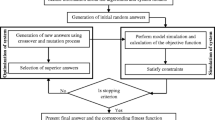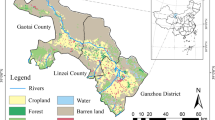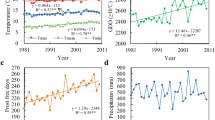Abstract
Crop production faces an increasing threat due to anthropogenic activities and natural hazards. Crop rotation is a tool that can address these issues in crop production. This study proposes an optimization model that generates a crop rotation plan using spatiotemporal suitability scores given a set of crops, with an objective to maximize the total suitability of the assignment of crops while satisfying principles of crop rotation such as suitability threshold and crop succession requirements. Biophysical and climatic characteristic data from Marinduque, Philippines, with upland rice, corn, and mungbean as crops, were used to validate the model. The results show that with a minimum suitability threshold of 0.6, an optimal crop rotation plan for one annual cycle included corn and mungbean for one (May to October) and two (June to August, September to November) cropping periods, respectively. Throughout each cropping period, the corn and mungbean will cover 46.64% and 10.33% of the arable land, respectively. Based on the crop rotation plan, corn can be cultivated along the shorelines except in the southeast area of the island, where mungbean is more suitable. The results suggest that other crops should be considered since the current set of crops leaves 43% of the arable land unutilized. This model can be used for any combination of crops and other spatiotemporal suitability factors, allowing it to be applied to different sites and scenarios.


Similar content being viewed by others
Data availability
All data generated or analyzed during this study are included in this published article.
Code availability
The codes which were executed in Spyder IDE and solved using Gurobi 9.1 can be found online at https://github.com/SonEmer/Crop-Rotation/blob/main/Crop-Rotation.py.
References
Mekuria, M. (2018). The link between agricultural production and population dynamics in Ethiopia: a review. Advances in Plants Agriculture Research. https://doi.org/10.15406/apar.2018.08.00336
Ray, D. K., & Foley, J. A. (2013). Increasing global crop harvest frequency: Recent trends and future directions. Environmental Research Letters. https://doi.org/10.1088/1748-9326/8/4/044041
Ray, D. K., Mueller, N. D., West, P. C., & Foley, J. A. (2013). Yield Trends Are Insufficient to Double Global Crop Production by 2050. PLoS ONE. https://doi.org/10.1371/journal.pone.0066428
Stehfest, E., Heistermann, M., Priess, J. A., Ojima, D. S., & Alcamo, J. (2007). Simulation of global crop production with the ecosystem model DayCent. Ecological Modelling. https://doi.org/10.1016/j.ecolmodel.2007.06.028
Lobell, D. B., & Gourdji, S. M. (2012). The influence of climate change on global crop productivity. Plant Physiology. https://doi.org/10.1104/pp.112.208298
Lobell, D. B., Burke, M. B., Tebaldi, C., Mastrandrea, M. D., Falcon, W. P., & Naylor, R. L. (2008). Prioritizing climate change adaptation needs for food security in 2030. Science, 319(5863), 607–610. https://doi.org/10.1126/science.1152339
Cong, R. G., & Brady, M. (2012). The interdependence between rainfall and temperature: Copula analyses. The Scientific World Journal. https://doi.org/10.1100/2012/405675
Wolf, J., Bindraban, P. S., Luijten, J. C., & Vleeshouwers, L. M. (2003). Exploratory study on the land area required for global food supply and the potential global production of bioenergy. Agricultural Systems. https://doi.org/10.1016/S0308-521X(02)00077-X
Popp, J., Petõ, K., & Nagy, J. (2013). Pesticide productivity and food security: A review. Agronomy for Sustainable Development. https://doi.org/10.1007/s13593-012-0105-x
Khan, S., Hanjra, M. A., & Mu, J. (2009). Water management and crop production for food security in China: A review. Agricultural Water Management. https://doi.org/10.1016/j.agwat.2008.09.022
Balmford, A., Green, R. E., & Scharlemann, J. P. (2005). Sparing land for nature: Exploring the potential impact of changes in agricultural yield on the area needed for crop production. Global Change Biology. https://doi.org/10.1111/j.1365-2486.2005.001035.x
Knox, J. W., Kay, M. G., & Weatherhead, E. K. (2012). Water regulation, crop production, and agricultural water management-understanding armer perspectives on irrigation efficiency. Agricultural Water Management. https://doi.org/10.1016/j.agwat.2011.06.007
Ali, M. H., & Talukder, M. S. (2008). Increasing water productivity in crop production-A synthesis. Agricultural Water Management. https://doi.org/10.1016/j.agwat.2008.06.008
Bethlenfalvay, G. J. (2015). Mycorrhizae and crop productivity. Mycorrhizae in Sustainable Agriculture, 54, 1–27. https://doi.org/10.2134/asaspecpub54.c1
Mandal, K. G., Misra, A. K., Hati, K. M., Bandyopadhyay, K. K., & Ghosh, P. K. (2004). Rice residue- management options and effects on soil properties and crop productivity. Journal of Food Agriculture and Environment, 2(January), 224–231.
Ogle, S. M., Swan, A., & Paustian, K. (2012). No-till management impacts on crop productivity, carbon input and soil carbon sequestration. Agriculture, Ecosystems and Environment. https://doi.org/10.1016/j.agee.2011.12.010
Fageria, N. K., Baligar, V. C., & Bailey, B. A. (2005). Role of cover crops in improving soil and row crop productivity. Communications in Soil Science and Plant Analysis. https://doi.org/10.1080/00103620500303939
Lal, R., & Moldenhauer, W. C. (1987). Effects of soil erosion on crop productivity. Critical Reviews in Plant Sciences. https://doi.org/10.1080/07352688709382244
Ponce, E. R. (2004). Special issue in agriculture. Philippine Institute for Development Studies, Bureau of Agricultural Research. Retrieved from https://dirp3.pids.gov.ph/ris/books/pidsbk04-agriculture.pdf
Mohler, C. (2009). Crop Rotation on Organic Farms: A Planning Manual. Natural Resource, Agriculture and Engineering Service (NRAES) Cooperative Extension.
Brankatschk, G., & Finkbeiner, M. (2015). Modeling crop rotation in agricultural LCAs—Challenges and potential solutions. Agricultural Systems. https://doi.org/10.1016/j.agsy.2015.05.008
Forrester, R. J., Rodriguez, M., Forrester, R., & Rodriguez, M. (2018). An integer programming approach to crop rotation planning at an organic farm. The UMAP Journal, 38(4), 5–25. Retrieved from http://www.comap.com/product/?idx=1617
Alfandari, L., Lemalade, J. L., Nagih, A., & Plateau, G. (2011). A MIP flow model for crop-rotation planning in a context of forest sustainable development. Annals of Operations Research, 190(1), 149–164. https://doi.org/10.1007/s10479-009-0553-0
Dos Santos, L. M. R., Michelon, P., Arenales, M. N., & Santos, R. H. S. (2011). Crop rotation scheduling with adjacency constraints. IDEAS. https://doi.org/10.1007/s10479-008-0478-z
de Oliveira, D. G., Delgado, A. R. S., Ventura, S. D., Cruz, M. D., & Rodrigues, P. C. P. (2019). Binary programming for the simulation of crop rotation and animal transit in an integrated crop-livestock system. Revista Ciencia Agronomica. https://doi.org/10.5935/1806-6690.20190015
Bargués-Ribera, M., & Gokhale, C. S. (2020). Eco-evolutionary agriculture: Host-pathogen dynamics in crop rotations. PLoS Computational Biology. https://doi.org/10.1371/journal.pcbi.1007546
Maqrot, S., de Givry, S., Quesnel, G., & Tchamitchian, M. (2017). A Mixed Integer Programming Reformulation of the Mixed Fruit-Vegetable Crop Allocation Problem. In Lecture Notes in Computer Science (including subseries Lecture Notes in Artificial Intelligence and Lecture Notes in Bioinformatics). Springer. https://doi.org/10.1007/978-3-319-60045-1
Filippi, C., Mansini, R., & Stevanato, E. (2017). Mixed integer linear programming models for optimal crop selection. Computers and Operations Research. https://doi.org/10.1016/j.cor.2016.12.004
Kharisma, A., & Perdana, T. (2019). Linear programming model for vegetable crop rotation planning: A case study. International Journal of Agricultural Resources, Governance and Ecology. https://doi.org/10.1504/IJARGE.2019.104203
Nevo, A., & Amir, I. (1991). CROPLOT: An expert system for determining the suitability of crops to plots. Agricultural Systems, 37(3), 225–241. https://doi.org/10.1016/0308-521X(91)90034-8
Bailey, L. H. (1907). Cyclopedia of American Agriculture. Philippine Institute for Development Studies, Bureau of Agricultural Research.
Salvacion, A. R. (2017). Fuzzy logic approach to explore climatic limitation on corn production in the Philippines. Spatial Information Research. https://doi.org/10.1007/s41324-017-0109-3
Dury, J., Schaller, N., Garcia, F., Reynaud, A., & Bergez, J. E. (2011). Models to support cropping plan and crop rotation decisions. A view. Agronomy for Sustainable Development, 32(2), 567–580. https://doi.org/10.1007/s13593-011-0037-x
Sarker, R., & Quaddus, M. (2002). Modelling a nationwide crop planning problem using a multiple criteria decision making tool. Computers & Industrial Engineering, 42(2), 541–553. https://doi.org/10.1016/S0360-8352(02)00022-0
Salvacion, A. R., & Magcale-Macandog, D. B. (2015). Spatial analysis of human population distribution and growth in Marinduque Island, Philippines. Journal of Marine and Island Cultures. https://doi.org/10.1016/j.imic.2015.06.003
Salvacion, A. R., & Martin, A. A. (2016). Climate change impact on corn suitability in Isabela province, Philippines. Journal of Crop Science and Biotechnology. https://doi.org/10.1007/s12892-016-0019-2
Salvacion, A. (2017). Exploring determinants of child malnutrition in Marinduque Island Philippines. Human Ecology. https://doi.org/10.1007/s10745-017-9951-0
Salvacion, A. R. (2020). Spatial pattern and determinants of village level poverty in Marinduque Island, Philippines. GeoJournal. https://doi.org/10.1007/s10708-018-9944-6
Salvacion, A. R. (2021). Mapping land limitations for agricultural land use planning using fuzzy logic approach: a case study for Marinduque Island, Philippines. GeoJournal. https://doi.org/10.1007/s10708-019-10103-4
Leyso, N. L. C., & Palatino, M. C. (2020). Detecting local clusters of under-5 malnutrition in the province of Marinduque, Philippines using spatial scan statistic. Nutrition and Metabolic Insights, 13, 117863882094067. https://doi.org/10.1177/1178638820940670
Okabe, M. (2019). Inferences and descriptive analyses on education, livelihoods, and rural poverty through fieldwork and tailored household survey in Marinduque, the Philippines. Application/pdf.
Sys, C., van Ranst, E., Debayeye, J., & Beernaert, F. (1993). Land Evaluation part III: Crop requirements. Agricultural Publications. General Administration for Development Cooperation, Belgium. Retrieved from https://www.researchgate.net/publication/324330469. Land Evaluation Part 3 Crop Requirements
Arraudeau, M. A. & Vergara, B. S. (1988). A Farmer’s Primer on Growing Upland Rice.
The World Vegetable Center (2016). Mungbean seed production training manual. Retrieved from https://avrdc.org/download/publications/manuals/Mungbean-seed-productionSouth-Asia.pdf
Gerpacio, R. V., Labios, J. D., Labios, R. V., & Diangkinay, E. I. (2004). Maize in the Philippines: Production Systems, Constraints, and Research Priorities. Retrieved from https://ageconsearch.umn.edu/record/7650/files/mp04ge01.pdf
Salvacion, A. R. (2017). Fuzzy logic approach to explore climatic limitation on corn production in the Philippines. Spatial Information Research, 25(3), 421–429. https://doi.org/10.1007/s41324-017-0109-3
Province of Marinduque. (n.d.). Agriculture, Fishery and Livestock. Province of Marinduque Official Website. Retrieved January 18, 2022, from https://marinduque.gov.ph/agriculture-fishery-and-livestock/#:~:text=For%202020%20vegetable%20production%20generated,by%20farmers%20in%20the%20barangays.
Tahat, M. M., Alananbeh, K. M., Othman, Y. A., & Leskovar, D. I. (2020). Soil health and sustainable agriculture. Sustainability. https://doi.org/10.3390/su12124859
Acknowledgements
The authors would like to thank the anonymous reviewers for their valuable comments.
Funding
No funding was received to assist with the preparation of this manuscript.
Author information
Authors and Affiliations
Contributions
All the authors contributed to the design and implementation of the research, analysis of the results, and writing of the manuscript.
Corresponding author
Ethics declarations
Competing interest
The authors declare no competing interests.
Ethical approval
Not applicable.
Consent to participate
Not applicable.
Consent for publication
Not applicable.
Additional information
Publisher's Note
Springer Nature remains neutral with regard to jurisdictional claims in published maps and institutional affiliations.
Supplementary Information
Below is the link to the electronic supplementary material.
Rights and permissions
About this article
Cite this article
Rico, E.R., Lutero, D.S., Nazareno, A.L. et al. A crop rotation model for Marinduque, Philippines. Spat. Inf. Res. 30, 461–467 (2022). https://doi.org/10.1007/s41324-022-00435-8
Received:
Revised:
Accepted:
Published:
Issue Date:
DOI: https://doi.org/10.1007/s41324-022-00435-8




